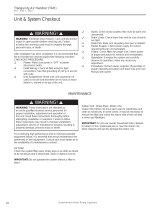
4
GENERAL INFORMATION
The unit has been tested and certifi ed by AHRI for capacity
and effi ciency and will provide many years of safe and
dependable comfort, providing it is properly installed
and maintained. Abuse, improper use, and/or improper
maintenance can shorten the life of the appliance and
create unsafe hazards. Please read all instructions before
installing the unit.
Before You Install this Unit
√ This equipment is securely packaged at the time of
shipment and upon arrival should be carefully inspected
for damage prior to installing the equipment at the job
site. Claims for damage (apparent or concealed) should
be fi led immediately with the carrier.
√ The cooling load of the area to be conditioned must be
calculated and a system of the proper capacity selected.
It is recommended that the area to be conditioned be
completely insulated and vapor sealed.
√ Check the electrical supply and verify the power supply
is adequate for unit operation. The system must be wired
and provided with circuit protection in accordance with
local building codes. If there is any question concerning
the power supply, contact the local power company.
√ Verify the air delivery of the air handler is adequate to
handle the static pressure drop of the coil, fi lter, and
duct work.
Table 1. Minimum Unit Clearances
INSTALLATION CLEARANCES
Left Side ......... 0 Inches Right Side ...... 0 Inches
Back ............... 0 Inches
Front ...........
†
See Notes
†
NOTES:
Alcove Installations - Allow 24 in. minimum clearance
from front of unit to nearest wall or partition for servicing.
Recommended clearance is 36 in.
Closet installations - require a return air grill installed in
the door or a partially louvered door across the opening
for proper air circulation. For clearances 6” or greater, the
closet must have an open free area of 235 in
2
minimum.
For special clearances between 1” - 5”, requirements
are a louvered door with a minimum of 250 in
2
(1613
cm
2
) free area. A fully louvered closet door is strongly
recommended for both installation types.
REAR
RIGHT
SIDE
LEFT
SIDE
FRONT
Locating the Air Handler
• Survey the job site to determine the best location
for mounting the unit. Consideration should be given
to availability of electric power, service access, and
noise.
• The dimensions of the room or alcove must be able
to accommodate the overall size of the unit and the
installation clearances listed in Table 1. Physical
dimensions for this air handler are also shown in Figure
4 (page 13).
• The air handler should be installed before routing the
refrigerant tubing.
Minimum Clearances
• This appliance must be installed in accordance with
clearances listed in Table 1. The air handler must be
installed with ample clearance for easy access to the
air fi lter, blower assembly, burner assembly, controls,
and vent connections.
• Suffi cient clearance for unobstructed airfl ow through a
louvered door must be maintained in order to achieve
rated performance.
Operation of Air Handler During Construction
CAUTION:
Failure to follow these instructions will void the
factory warranty and may signifi cantly reduce
the life or the performance of the air handler,
and/or result in other unsafe conditions. It is
the responsibility of the installing contractor
to insure these provisions are met.
Operating an air handler in a construction environment
can cause the appliance a variety of problems. Proper
use of commercial portable space heating equipment
during construction is recommended. This air handler may
be used during construction if it is not in violation of any
applicable codes and the following criteria are met:
• The installation (including electrical supply, gas supply,
and duct work), must meet all applicable codes and
be permanently installed according to the instructions
supplied with the air handler.
• The air handler must be controlled by a properly installed
thermostat that complies with the current provisions
of the NEC (ANSI/NFPA 70) and all applicable codes
having jurisdiction. Thermostat connections must be
made in accordance with instructions supplied with the
air handler and thermostat.
• The installation must include a properly installed fi lter in
the return air system with no by-pass air. The fi lter must be
inspected frequently and replaced when necessary.
• Return air must be supplied unrestricted and located
such that dust and gases from construction activity are
not introduced into the circulating air system.
• Before occupying the structure: The fi lter must be
replaced or cleaned, the duct work must be inspected






















